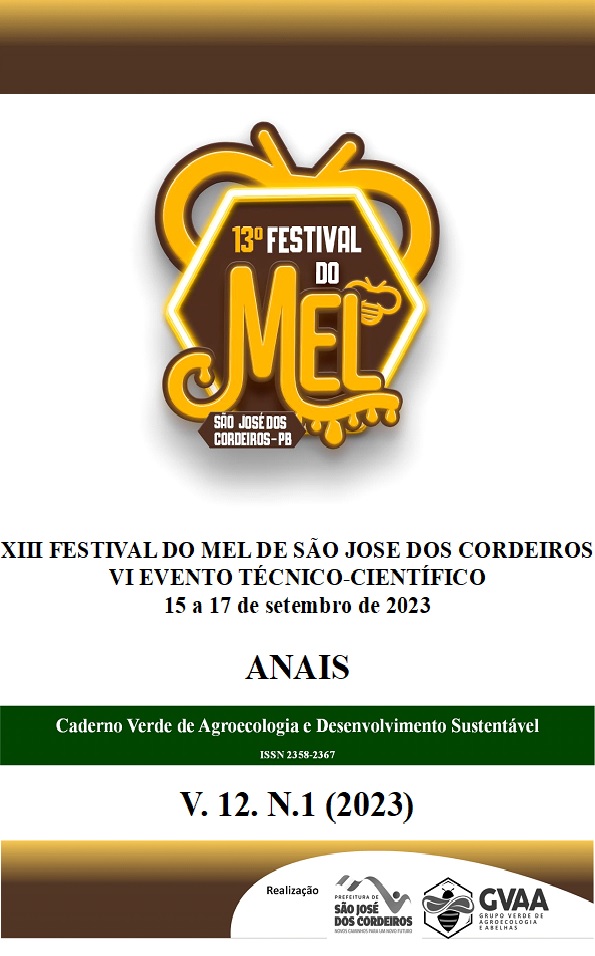Identification of differentially abundant bacteria in the gut of bees from different biomes in the State of Paraíba
Keywords:
Ancom, Biomas, Intestino, ApibacterAbstract
The contact between organisms within a hive ensures the transmission of microorganisms between individuals and the maintenance of intraspecific microbial characteristics. The core microbiome refers to any set of microbial taxa specific to a host or environment of interest. The bacterial core of A. mellifera bees is composed of six main families: Acetobacteriaceae (Parasaccharibacter apium), Bifidobacteriaceae, Lactobacillaceae, Neisseriaceae (Snodgrassella alvi), Orbaceae (Gilliamella apicola, Frischella perrara) and Rhizobiaceae (Bartonella apis). Despite the existence of bacteria in common among bees of the A. mellifera species, some bacterial species can stand out in certain landscapes and due to factors such as climate, feeding, soil, water, etc., may favor their development. In order to identify bee gut bacteria that are differentially abundant between bee samples from two regions of Paraíba, 5 samples of 20 individuals were collected from different hives belonging to the Federal University of Paraíba from different regions of Paraíba, Areia (Atlantic forest) and São João do Cariri (Caatinga), and sent to the Laboratory of Analysis of Products of Animal Origin (LAPOA / CCA / UFPB), in the municipality of Areia - PB. In a sterile environment, all the abdominal contents of the bees were collected and the DNA was extracted, the genomic libraries were generated and the sequencing was performed in a MiSeq equipment (Illumina). The obtained sequences were processed using the DADA2 software and a microbiome composition analysis - ANCOM was performed using the QIIME 2-2020 platform. ANCOM identified a differentially abundant taxon at the genus level, Apibacter (w = 7). The abundances of bacteria of the genus Apibacter were higher in bees from the Atlantic Forest compared to those from the Caatinga (ANOVA: Apibacter p-value = 0.0242). Studies indicate that bacteria of the genus Apibacter encode genes that are responsible for the synthesis of amino acids and for the degradation of monosaccharides that are toxic to bees. Possibly edaphoclimatic characteristics found in the Atlantic Forest region favor the development of bacteria of this genus.
Downloads
Published
How to Cite
Issue
Section
License
Copyright (c) 2023 Kilmer Oliveira Soares, Celso José Bruno de Oliveira, Romildo da Silva Neves Neves, Leonardo Souza do Prado Junior , Adriana Evangelista Rodrigues; Aline Carla de Medeiros; Rosilene Agra da Silva, Patricio Borges Maracaja

This work is licensed under a Creative Commons Attribution 4.0 International License.
Termo de cessão de direitos autorias
Esta é uma revista de acesso livre, em que, utiliza o termo de cessão seguindo a lei nº 9.610/1998, que altera, atualiza e consolida a legislação sobre direitos autorais no Brasil.
O(s) autor(es) doravante designado(s) CEDENTE, por meio desta, publica a OBRA no Caderno Verde de Agroecologia e Desenvolvimento Sustentável, representada pelo Grupo Verde de Agroecologia e Abelhas (GVAA), estabelecida na Rua Vicente Alves da Silva, 101, Bairro Petrópolis, Cidade de Pombal, Paraíba, Brasil. Caixa Postal 54 CEP 58840-000 doravante designada CESSIONÁRIA, nas condições descritas a seguir:
O CEDENTE declara que é (são) autor(es) e titular(es) da propriedade dos direitos autorais da OBRA submetida.
O CEDENTE declara que a OBRA não infringe direitos autorais e/ou outros direitos de propriedade de terceiros, que a divulgação de imagens (caso as mesmas existam) foi autorizada e que assume integral responsabilidade moral e/ou patrimonial, pelo seu conteúdo, perante terceiros.
O CEDENTE mantêm os direitos autorais e concedem à revista o direito de divulgação da OBRA, com o trabalho simultaneamente licenciado sob a Licença Creative Commons do tipo atribuição CC-BY.
O CEDENTE têm autorização para distribuição não-exclusiva da versão do trabalho publicada nesta revista.
O CEDENTE têm permissão e são estimulados a publicar e distribuir seu trabalho online (ex.: em repositórios institucionais ou na sua página pessoal) a qualquer ponto antes ou durante o processo editorial, já que isso pode gerar alterações produtivas, bem como aumentar o impacto e a citação do trabalho publicado.








